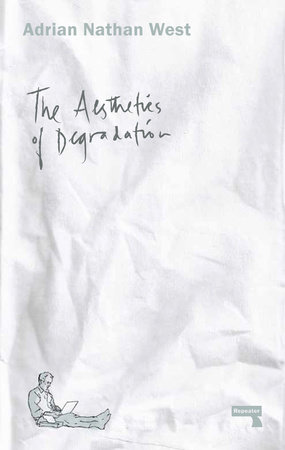
First things first: this is not an easy read. Adrian Nathan West’s The Aesthetics of Degradation is a book about the appeal of pornography, and about how it, as a genre, has become increasingly more intense over the years. It contains descriptions of harrowing acts and decidedly extreme personalities; it explores the areas in which the genre crosses over into something mortally reprehensible or illegal. But West’s book also delves into the question of why so many people are drawn to it, and leaves neither the author nor the reader feeling exempt from the observations made therein.
Much of that has to do with the way in which West establishes a sense of distance, starting with the opening pages. It begins with an everyday sight: a man in the midst of his daily routine deciding to stop at a video store and peruse their offerings. “It feels like something less than a coincidence when, after five or seven minutes, he pushes open the spring-loaded saloon doors leading to the adult section,” West writes–and note the specificity of the language. These first few pages take the reader into the mind of this character, and give a very tactile sense of the space through which he moves. This is vitally important, because the “he” referred to in these pages may well be a stand-in for the author: eventually, the “he” begins to be referred to as “the narrator.” “The narrator is indifferent to pornography in the main,” West write–but still, the narrator enters the room, looks around, and is drawn in by the videos around him.
It’s an interesting way to create a layered sense of alienation. “The narrator” is a much more formal way of saying “I,” but it’s also a way by which West establishes a sense of distance between the reader and the narrator. And, given the subject matter of this book, a sense of alienation and distance seems entirely appropriate: West is writing about places where the lines between performer and role, between narrative and fantasy, and between fact and fiction all blur to a surreal extent.
The use of “I” in the middle of the book is frequently used to showcase different perspectives: “When he wished to hurt me, my boyfriend would imply that I only liked to have sex on camera. It’s not true, I thought.” Here, “I” seems distinct from “the narrator”–but it’s jarring to read regardless. It can put the reader in the position of empathizing more with the figure being channeled in those few sentences than with the more remote narrator–all of which adds further layers to things.
I do suspect, though, that a reader’s gender and sexuality may inform how they react to some of the material West includes in this book. As a heterosexual male reading a book that frequently critiques the desires and watching habits of other heterosexual men, I found myself feeling very complicit here; someone with a different background might feel differently. (Or not.) West’s book leaves the reader feeling acutely aware of questions like this, and of the constantly shifting narrative ground on which this hybrid work exists.
By the end of the book, West fully documents that tension between “the narrator” and “I,” tying in questions of potential violence and actual violence as he goes. It’s a powerful ending to a book that demands self-examination and travels down numerous disquieting lines of inquiry. The Aesthetics of Degradation is a short book and moves at a fast pace, but there’s nothing light about it. West’s observations and arguments offer plenty to ponder, and the societal indictment that results attains an even greater power along the way.
***
The Aesthetics of Degradation
by Adrian Nathan West
Repeater; 111 p.
Follow Vol. 1 Brooklyn on Twitter, Facebook, and sign up for our mailing list.
